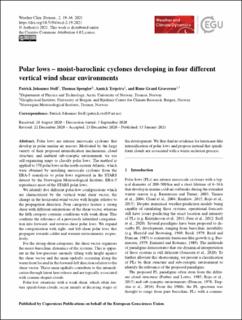| dc.contributor.author | Stoll, Patrick | |
| dc.contributor.author | Spengler, Thomas | |
| dc.contributor.author | Terpstra, Annick | |
| dc.contributor.author | Graversen, Rune | |
| dc.date.accessioned | 2021-10-13T08:57:33Z | |
| dc.date.available | 2021-10-13T08:57:33Z | |
| dc.date.created | 2021-09-27T17:14:33Z | |
| dc.date.issued | 2021 | |
| dc.identifier.issn | 2698-4016 | |
| dc.identifier.uri | https://hdl.handle.net/11250/2789556 | |
| dc.description.abstract | Polar lows are intense mesoscale cyclones that develop in polar marine air masses. Motivated by the large variety of their proposed intensification mechanisms, cloud structure, and ambient sub-synoptic environment, we use self-organising maps to classify polar lows. The method is applied to 370 polar lows in the north-eastern Atlantic, which were obtained by matching mesoscale cyclones from the ERA-5 reanalysis to polar lows registered in the STARS dataset by the Norwegian Meteorological Institute. ERA-5 reproduces most of the STARS polar lows.
We identify five different polar-low configurations which are characterised by the vertical wind shear vector, the change in the horizontal-wind vector with height, relative to the propagation direction. Four categories feature a strong shear with different orientations of the shear vector, whereas the fifth category contains conditions with weak shear. This confirms the relevance of a previously identified categorisation into forward- and reverse-shear polar lows. We expand the categorisation with right- and left-shear polar lows that propagate towards colder and warmer environments, respectively.
For the strong-shear categories, the shear vector organises the moist-baroclinic dynamics of the systems. This is apparent in the low-pressure anomaly tilting with height against the shear vector and the main updrafts occurring along the warm front located in the forward-left direction relative to the shear vector. These main updrafts contribute to the intensification through latent heat release and are typically associated with comma-shaped clouds.
Polar-low situations with a weak shear, which often feature spirali-form clouds, occur mainly at decaying stages of the development. We thus find no evidence for hurricane-like intensification of polar lows and propose instead that spirali-form clouds are associated with a warm seclusion process. | en_US |
| dc.language.iso | eng | en_US |
| dc.publisher | Copernicus | en_US |
| dc.rights | Navngivelse 4.0 Internasjonal | * |
| dc.rights.uri | http://creativecommons.org/licenses/by/4.0/deed.no | * |
| dc.title | Polar lows – moist-baroclinic cyclones developing in four different vertical wind shear environments | en_US |
| dc.type | Journal article | en_US |
| dc.type | Peer reviewed | en_US |
| dc.description.version | publishedVersion | en_US |
| dc.rights.holder | Copyright 2021 the authors | en_US |
| cristin.ispublished | true | |
| cristin.fulltext | original | |
| cristin.qualitycode | 1 | |
| dc.identifier.doi | 10.5194/wcd-2-19-2021 | |
| dc.identifier.cristin | 1939261 | |
| dc.source.journal | Weather and Climate Dynamics (WCD) | en_US |
| dc.source.pagenumber | 19-36 | en_US |
| dc.identifier.citation | Weather and Climate Dynamics (WCD). 2021, 2, 19-36. | en_US |
| dc.source.volume | 2 | en_US |

